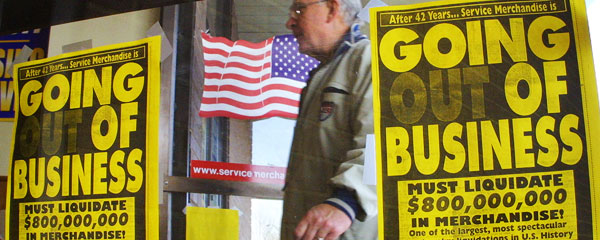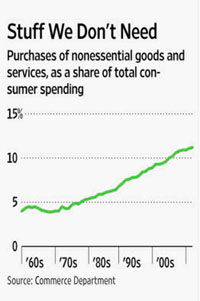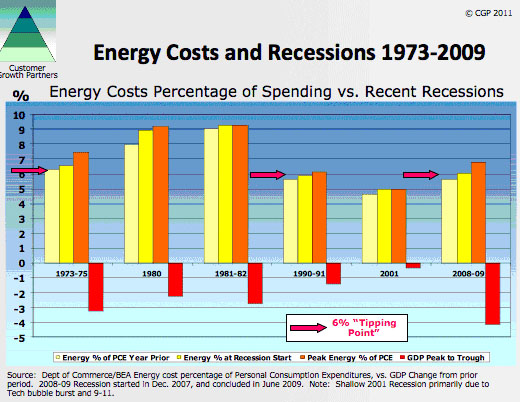For months now we have talked about the devil's bargain struck by the powers that be. In that bargain, the artificial recovery has been paid for with stimulus, dollar debasement and corporate cost cutting, with the piece de resistance of jobs moving offshore.
This is a combo that works well for the upper regions of U.S. economic society - the top 30%. The "wealth effect" so cherished by the Federal Reserve, in which Americans feel better about the value of their paper assets going up, requires owning a good chunk of paper assets in the first place.
But the problem with the scheme - as asset values are pumped up and purchasing power is eroded - comes with the bottom 70%.
These are the people who do not matter to the stock market, because they do not drive spending trends. They are not buying yoga pants at LuluLemon Athletica or burritos at Chipotle Mexican Grill. They are not gorging on "stuff." But the top 30% are picking up the slack quite handily... so Wall Street doesn't care.
Stuff We Don't Need
Americans are quite good at buying "stuff." And we haven't stopped. As The Wall Street Journal reports,
A non-scientific study of Commerce Department data suggests that in February, U.S. consumers spent an annualized $1.2 trillion on non-essential stuff including pleasure boats, jewelry, booze, gambling and candy. That's 11.2% of total consumer spending, up from 9.3% a decade earlier and only 4% in 1959, adjusted for inflation.So what's the problem, if we are now back to our old ways? It comes back to that 70/30 split again. The gap between Americans with discretionary income and those without is getting wider and wider. It threatens to become a yawning gulf.
We can see from the above data that the buying binge is still ongoing. But there is further evidence that the lower strata of U.S. earners are not participating. This is where the cracks come in.
The Canary in the Low-Price Coal Mine
When it comes to the consumer spending habits of the financially strapped, Wal-Mart is an excellent barometer. The low-price behemoth is spread all across the United States, and attracts those shoppers who need to save a buck.
And right now, Wal-Mart CEO Mike Duke has an alarming message: His customers are running out of money.
Duke believes prices at the pump are a big factor. "We're seeing core consumers under a lot of pressure," he said in New York. "There's no doubt that rising fuel prices are having an impact."
"Purchases are really dropping off by the end of the month even more than last year," the Wal-Mart CEO added. "This end-of-month cycle is growing to be a concern."
Wal-Mart is sensitive to the calendar, CNNMoney reports, because of the lower income shopper's habit of living "paycheck to paycheck." Bulk purchases are made early in the month, just after getting paid. As things get tighter, Wal-Mart shoppers are left with more and more month at the end of their money (rather than the other way round).
This split between haves and have-nots is exactly what one would expect from policies as they exist now. The result is practically tailor-made to order. In bailing out the megabanks to the tune of hundreds of millions to trillions, Washington and Wall Street robbed taxpayers blind to save a connected few. And the Federal Reserve's broader policies, aimed at pumping up the stock market, are destroying the U.S. economy from the bottom up through creeping inflation.
Facing the "Tipping Point"
Craig Johnson, president of research firm Consumer Growth Partners, believes we are headed toward a potential "tipping point" - and may have already passed it.
Johnson notes that, in five of the six U.S. recessions since 1970, energy prices crossing a key threshold have played a role. The situation is even worse this time - possibly the worst since the 1973-75 recession - because food costs are rising sharply too.
Again, you aren't hearing about this on CNBC because the stock market doesn't care. The invisible many are not playing a significant role in the earnings of public companies tied to discretionary spending.
But this trend is important because it is so unsustainable... and because the key drivers behind it are not getting better, they are getting worse.
As long as central banks attempt to prop up markets with artificial stimulus - and emerging market food and energy demand continues to rise - cost of living expenses will continue to rise too. There is the double whammy of a "speculative bid" under crude oil, grains, gasoline and other staples, coupled with the real fundamental shift of higher demand and less supply.
The possibility remains that crude oil could see a price collapse. In the event of a deflationary bust, all commodities could fall sharply in price. (We will talk more about that soon.)
But if that happened, it would only be against the backdrop of the global economy heading into a new tailspin. And once things picked up again - so too would the food and energy price ramp.
A Society Destroyed
This focus on the less fortunate is not emphasized as a call to class warfare or a bleeding-heart liberal crusade. Rather, it comes from a genuine source of alarm. If the divide between "haves" and "have-nots" grows too wide, America as we know it could be pulled to pieces.
Various studies have shown that large gaps in economic status are not good for society. Your humble editor witnessed this in a trip to Buenos Aires, Argentina, a few years back.
Buenos Aires itself, known as "the Paris of Latin America," was architecturally gorgeous. In terms of economic mix, you had a small population of those who were thriving - the type not to notice food and energy costs at all - and a much larger contingent of those struggling to get by on the equivalent of $5 a day.
When Argentina defaulted on its debt early in the last decade, low-income earners were hit hardest. In Buenos Aires alone, there were an estimated 40,000 "cartoneros," or waste pickers - destitute souls who scraped by looking for recyclables among garbage and pawnable items at dump sites.
As the venerable Lao Tzu once said, "If you do not change direction, you may end up where you are heading." Where we are heading now, in respect to American society at large, is toward a sort of Mad Max wasteland, in which a small portion of the population lives well with the equivalent of security fences and barbed wire, as the bulk of the population slowly descends into desperation and squalor.
It is not a pretty picture, but then neither is the idea of running out of money at Wal-Mart...
Not Used to It
The final concern here is the very real long-term threat of political and secular violence. America is slowly becoming like many other places in the world, where barbed wire and pockets of wealth among poverty are the norm.
But a crucial difference is that lower-middle-class Americans - a large portion of the 70% - are not accustomed to being destitute or nearly so.
When a segment of society has psychologically accepted the way things are, there is more of a tendency toward dormancy. The constant poor quietly accept their fate.
Yet those who find themselves newly headed in that direction - with memories of what used to be - are not likely to be so complacent. Instead, they are likely to get angry. There is a hidden fuse that has been lit, with physical and political violence the outcome when the bomb it is attached to explodes.
Your editor shudders to think what kind of political backlash we will see - and what vicious speeches and demagogue measures will be taken on both sides - when the weight of the problem hits full force. Be prepared, because none of this is happening by accident. We are progressing down a very deliberate path - a path of irresponsibility, greed and larceny, taking from the clueless many to enrich the connected few - and will soon enough be reaping what we sow.
Source: Taipan Publishing Group






Reader Comments
to our Newsletter